Recent Posts
Embracing Leadership Excellence: An Insightful Experience with The Restoration Institute
8/12/2024 (Permalink)
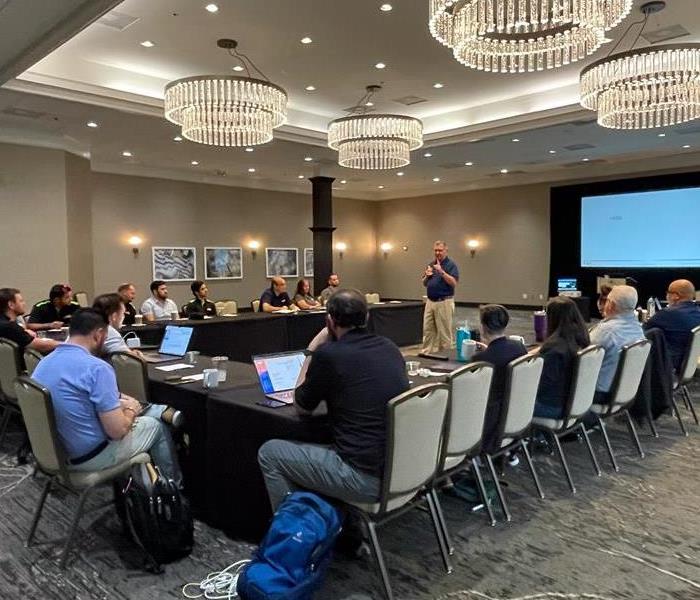 At SERVPRO Team Cuthbertson, we believe that investing in our employees’ development is crucial for fostering a thriving workplace.
At SERVPRO Team Cuthbertson, we believe that investing in our employees’ development is crucial for fostering a thriving workplace.
Our team recently had the incredible privilege of attending a dynamic leadership and management training led by instructor Dale Dohner of The Restoration Institute. Hosted at the inviting Hilton Orlando Altamonte Springs, the event fostered an inspiring atmosphere that was perfect for learning and growth.
At SERVPRO Team Cuthbertson, we believe that investing in our employees’ development is crucial for fostering a thriving workplace. We actively seek out opportunities like this training to empower our team members, equipping them with the tools they need to excel in their roles. By prioritizing ongoing education and professional growth, we aim to create an environment where everyone feels valued and motivated to contribute their best.
The training encompassed a diverse range of topics critical for effective leadership and management. Dale's practical insights, coupled with his engaging personal anecdotes, made each session not only relatable but also directly applicable to our unique work environments. His ability to connect theory with real-world scenarios was truly enlightening.
As we returned to our company, we carried with us a toolkit of new skills and perspectives. More importantly, we were invigorated with a fresh commitment to cultivate a culture of growth and innovation. We are eager to implement the strategies we learned and are optimistic about the positive transformations they will bring to our team dynamics and overall organizational success.
A heartfelt thank you goes out to The Restoration Institute and Dale Dohner for providing us with such a valuable experience. This training will undoubtedly influence our leadership journey for years to come. Here’s to embracing change, inspiring others, and leading with purpose! Together, we can create an environment where everyone thrives.
Understanding Biohazard Cleanup Services
8/12/2024 (Permalink)
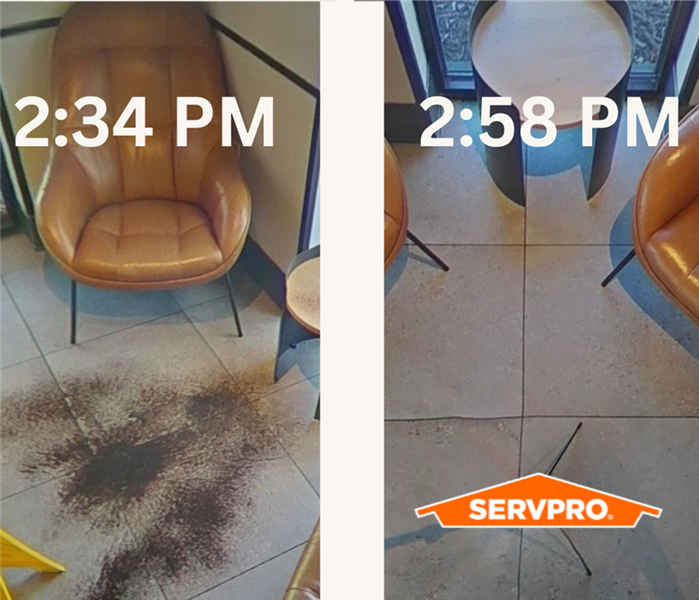 We offer specialized biohazard cleanup to address a variety of situations that can arise in both residential and commercial properties.
We offer specialized biohazard cleanup to address a variety of situations that can arise in both residential and commercial properties.
When it comes to ensuring a safe and healthy environment, biohazard cleanup is a critical service that demands professionalism, expertise, and compassion. At SERVPRO®, we are leaders in restoration and cleaning services, offering specialized biohazard cleanup to address a variety of situations that can arise in both residential and commercial properties.
Biohazard cleanup involves the removal and decontamination of hazardous materials that pose a risk to human health and the environment. These materials may include blood, bodily fluids, chemical spills, and other potentially infectious substances. Situations that may necessitate biohazard cleanup include crime scenes, trauma scenes, and infectious disease outbreaks like COVID-19.
Handling biohazard materials is not just about cleaning; it requires specialized training and equipment to ensure the safety of everyone involved. Our SERVPRO technicians are trained to understand the complexities of biohazard situations. They adhere to strict protocols and regulations, ensuring that all cleanup is done safely and effectively.
At SERVPRO, we follow a systematic approach to biohazard cleanup, ensuring thorough and effective results:
- Assessment: Technicians conduct a detailed assessment of the site to determine the extent of contamination and develop an appropriate plan of action.
- Containment: The area is contained to prevent the spread of contaminants, ensuring the safety of occupants and workers.
- Removal and Disposal: Biohazardous materials are carefully removed and disposed of in compliance with local, state, and federal regulations.
- Decontamination: The affected areas are cleaned and disinfected using specialized cleaning agents to eliminate any remaining pathogens.
- Restoration: After cleanup, SERVPRO can assist with restoring the property to its original condition, addressing any damage caused by the biohazard incident.
Our team is available 24/7, ready to assist in emergencies. With years of experience in biohazard cleanup, we understand the nuances of each situation and provide tailored solutions to meet the unique needs of each client. If you find yourself in need of biohazard cleanup, don’t hesitate to reach out for immediate assistance. Your safety and peace of mind are our top priorities.
Rapid Response to Weather-Related Disasters
8/12/2024 (Permalink)
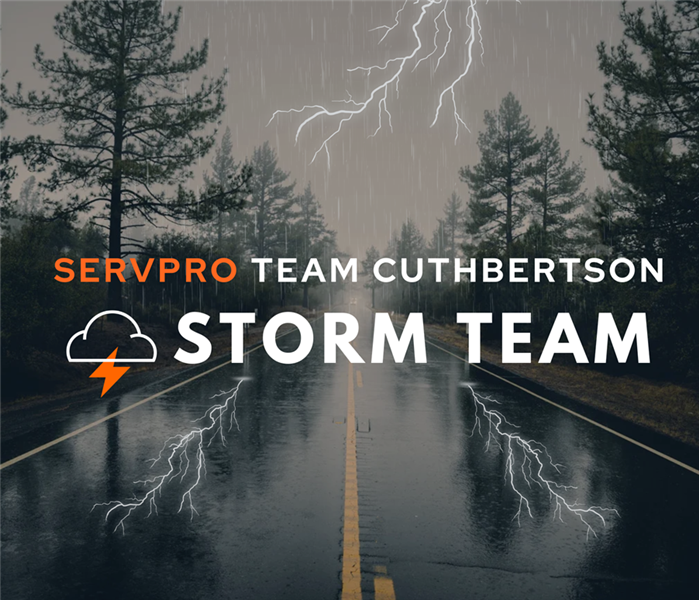 When extreme weather strikes, our SERVPRO Storm Team is here to provide fast, reliable, and comprehensive support.
When extreme weather strikes, our SERVPRO Storm Team is here to provide fast, reliable, and comprehensive support.
When severe weather strikes, the aftermath can be devastating for businesses and homeowners alike. From heavy rain and flooding to powerful winds and hail, the impact of such disasters can disrupt lives, damage property, and create chaos. In these critical moments, our SERVPRO® Storm Team is ready to respond quickly and efficiently, providing the support needed to navigate the challenges of recovery.
When dealing with weather-related disasters, the longer it takes to address the damage, the more extensive and costly it can become. Our SERVPRO Storm Team operates around the clock, ensuring that help is always just a phone call away. Our commitment to 24/7 availability means that we can mobilize our resources at any time, day or night, to respond to emergencies. Whether it's a flash flood, tornado, or snowstorm, our team is equipped to handle any situation, no matter how severe.
Our Storm Team consists of highly trained professionals who are experts in disaster recovery. Equipped with the latest technology and techniques, they assess damage quickly and develop comprehensive restoration plans tailored to the specific needs of each situation. From water extraction and structural drying to debris removal and cleanup, our technicians are prepared to tackle the challenges that arise from storm damage.
One of the advantages of the SERVPRO Storm Team is our vast network of local franchises. This allows us to mobilize resources from multiple locations, ensuring that we can scale our response based on the severity of the disaster. Our teams are familiar with the unique challenges posed by different regions and weather patterns, enabling them to act swiftly and effectively.
Beyond just emergency response, our SERVPRO Storm Team provides a wide array of services to facilitate recovery after a storm. These include: Water damage restoration, mold remediation, Board-up and Tarping services, as well as demolition and reconstruction.
At SERVPRO, we are not just about restoring properties; we are also committed to restoring communities. Our Storm Team understands the emotional toll that weather-related disasters can take on individuals and families. By providing prompt and compassionate service, we aim to help our clients feel supported during their time of need.
When extreme weather strikes, our Storm Team is here to provide fast, reliable, and comprehensive support. Our commitment to rapid response and effective restoration helps ensure that communities can bounce back from disasters stronger than ever. Remember, when disaster strikes, you don’t have to face it alone—SERVPRO is just a call away, ready to help you through the recovery process.
SERVPRO Partners With The University of Florida
2/21/2023 (Permalink)
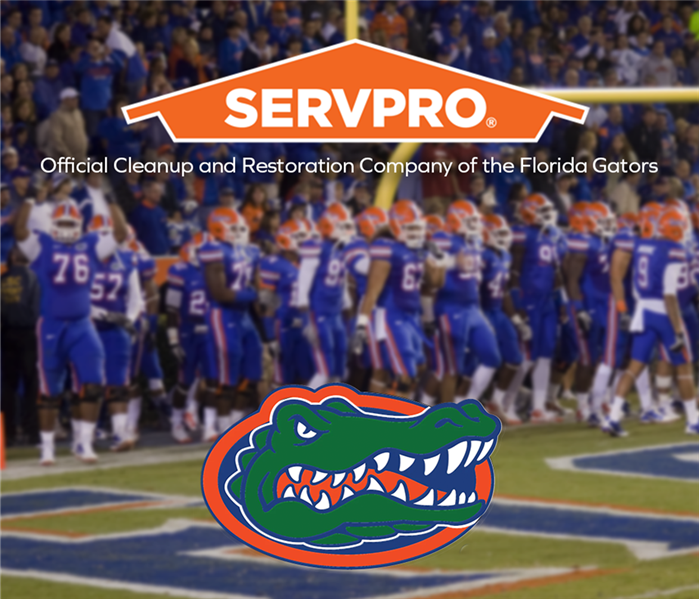 This new agreement marks a significant milestone in SERVPRO's commitment to supporting collegiate sports and the Florida Gators!
This new agreement marks a significant milestone in SERVPRO's commitment to supporting collegiate sports and the Florida Gators!
SERVPRO proudly announces its continued partnership with Florida Gators athletics for the 2023-24 athletic season. This new agreement marks a significant milestone in SERVPRO's commitment to supporting collegiate sports and the Florida Gators' commitment to providing successful and memorable experiences for their fans.
Through this agreement, SERVPRO and its franchises will continue to provide a wide range of services, such as on-site cleaning, restoration, and management solutions for all of the Gators' athletic venues. The company will also provide additional support through marketing initiatives and sponsorships. This relationship is a testament to both parties' dedication to delivering excellent service and creating memorable experiences for everyone involved.
What Happens During the Fire Damage Restoration Process?
12/5/2022 (Permalink)
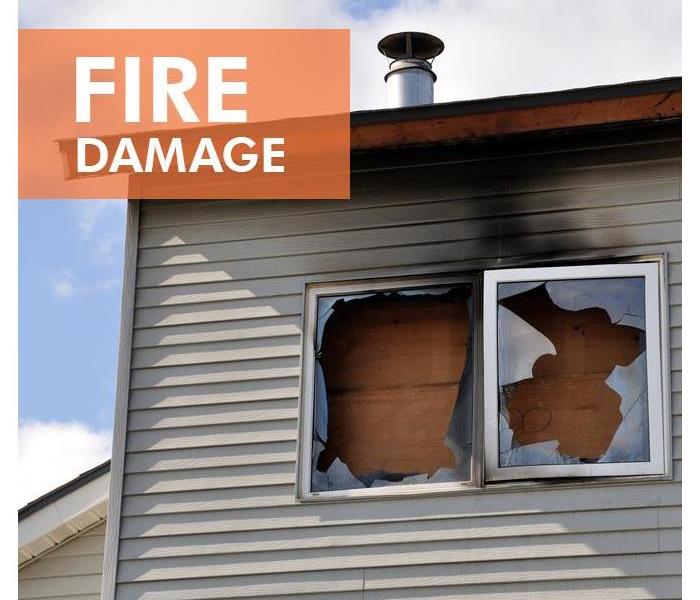 Board-up and security services
Board-up and security services
What Happens During the Fire Damage Restoration Process?
Every homeowner knows that fire damage can be devastating. After a fire, your house has been irreparably damaged and filled with smoke, soot, and ashes. The last thing you want to do is spend hours cleaning up the mess left behind by the fire if you don't have to! The good news is that there are trained professionals who can help make this process easier for you by performing fire damage restoration services.
Cleanup & restoration is a time-consuming and complicated process.
The fire damage restoration process is a very time-consuming and complicated process. It can take several days, weeks, or even months to fully restore the extent of damage caused by fire to your home, especially if you’ve suffered smoke and water damage, which are two common forms of property destruction resulting from fires.
When you call a fire damage restoration company after a fire has occurred in your house, they’ll perform a thorough evaluation of your home and determine what steps need to be taken before beginning repairs. They also keep records of all their work so that any insurance companies who may be involved in paying for the damages can verify that everything was done according to industry standards for safety and legality.
The company will also look for any other signs of damage, like mold or water damage. If there is any mildew present, they will use special equipment, such as fans and dehumidifiers, to remove it from the walls, ceiling, and floors before beginning repairs.
Board-up and security services.
Once the company has determined the extent of the damage, there is a good chance that your property might need board-up and security services. It's important for you to know that once boarded up and secured, your home will be safe from intruders and vandals. In addition to protecting your property from outside elements, it also protects your belongings from theft. If you were unable to go back into your home due to fire damage restoration services being performed on it, then this would be especially beneficial for protection purposes.
Water removal and dehumidification.
Firefighting efforts can leave your house damaged by water and humidity, especially if large amounts of water were used during the firefighting efforts. If you have experienced a fire in your home or business, you need to know what happens during the restoration process and how it will affect your family.
Water damage can cause structural damage to your home that requires repair. Water that was used for firefighting may have penetrated into cracks in walls or ceilings and caused mold growth on walls and ceilings.
Next, water removal and dehumidification are necessary. This is where you’ll see a lot of your water damage restoration company’s equipment. Any hazardous materials must be removed, along with any other materials that have been damaged by the fire and subsequent firefighting efforts. The goal here is to remove as much water as possible before it can cause further damage to your home or business.
The amount of time this process takes depends on how deep the water penetration is into your property. Once all traces of moisture have been removed from all affected areas, it may then be safe for you to reenter your home or business space again!
Cleaning and sanitizing materials in your home.
Once the drying & dehumidification process is completed, it's time for the cleaning and sanitizing of salvageable materials. The first step involves using an appropriate cleaning agent on your floors and walls to remove soil, soot, mold, and mildew from them. Once this process is completed, a fire restoration company will use an EPA-registered disinfectant that kills any remaining mold spores as well as any other pathogens found on your surfaces.
Depending on the extent of the damage, some salvageable materials can include:
- clothing
- furniture
- draperies
- toys
- appliances
If you've just experienced a fire, you may feel overwhelmed and confused about what to do next. The best thing to do is contact a professional fire damage restoration company, such as SERVPRO of DeLand. We will help you walk through each step of the restoration process so that your home can be restored back to its original condition as quickly and efficiently as possible. When it comes time for repairs or renovations, we'll be here!
What to Do After a Sewage Backup
11/2/2022 (Permalink)
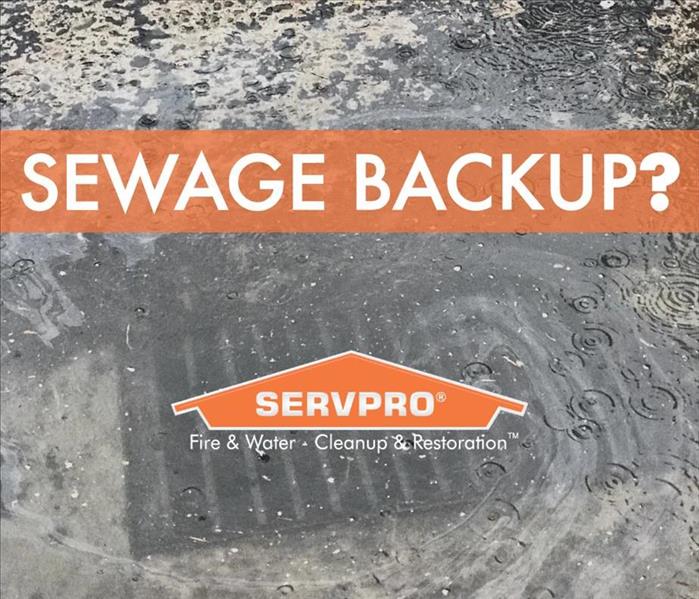 Sewage backups can be devastating, but they don’t have to be.
Sewage backups can be devastating, but they don’t have to be.
What to Do After a Sewage Backup
Sewage backups can be nasty, but you can avoid further damage by acting quickly. Sewage backups are one of the worst things that can happen to your home. But if you act quickly, you may be able to limit the damage and keep yourself safe.
If your home or business in DeLand, FL, has experienced a sewage backup, follow these steps:
Stay Safe
Sewage water is full of bacteria and viruses, so it is important to make sure you stay safe after a sewage loss. This means avoiding contact with anything that was in contact with the sewage water, as well as any tap that may have been contaminated by sewage.
- Do not touch anything that has come into contact with water.
- Don't use appliances or electronics that were in contact with water.
- Don't use anything that was in contact with water unless it has been cleaned by a professional cleaning service. These include clothes, towels, bedding, food items (including canned goods), kitchen utensils, and eating utensils.
- Do not drink from taps
Stay Out of Contaminated Areas
If you have had a sewage backup in your home, do not go into any areas that were contaminated by the flood water. These include the room where the sewage backup occurred and any rooms that were flooded with sewage (even if only partially).
If you can't avoid these areas, wear protective gear such as thick gloves and rubber boots when entering them.
Call a Professional Cleanup Company
If you've found yourself in this unfortunate situation, the first step should be calling a professional cleanup company. They'll know what to do and how to clean up your home or business after a sewage backup. You may have some questions about what kind of equipment they use and whether it's safe for people with allergies or other sensitivities. The good news is that most professionals will work with you to make sure everyone involved is protected from exposure risks.
If you're worried about insurance companies, don't be! A professional cleanup service can assist when filing claims with your insurance provider. So, in addition to helping get rid of the mess itself, these pros can help keep everything else on track when it comes time for reimbursements!
Contact Your Insurance Company
The next thing you should do after a sewage backup is contact your insurance company. They need to know about the incident as soon as possible, so give them as much information as possible and make sure you have your insurance policy number handy. If you don't have insurance, call a professional cleanup company immediately instead of trying to clean up the mess yourself—it's just not worth the risk!
Act Quickly
If sewage backs up into your home, you need to act quickly to prevent further damage and limit further risks. A sewage backup can be very dangerous: it contains bacteria, viruses, and parasites that can cause serious illness.
Sewage backups can be devastating, but they don’t have to be. If you act quickly, you can minimize the damage and keep your home safe from potentially harmful bacteria. It’s important to stay out of contact with contaminated areas until a professional cleanup company arrives on the scene. Once that happens, it’s time for them to do their job so you can get back into your daily routine as soon as possible!
Actions to Take After a Fire
10/13/2022 (Permalink)
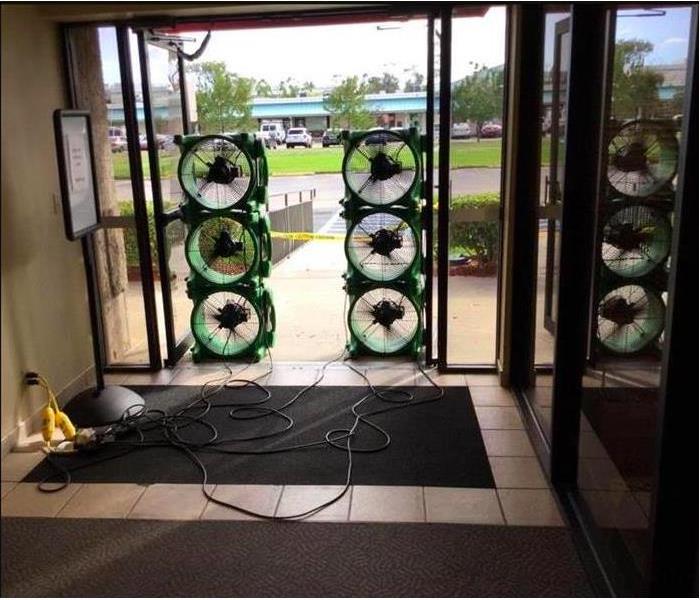 Smoke damage and odor can be difficult to clean, and a professional company such as SERVPRO of Delray Beach can help.
Smoke damage and odor can be difficult to clean, and a professional company such as SERVPRO of Delray Beach can help.
Actions to Take After a Fire
Fires can cause extensive damage to Delray Beach, FL homes and businesses, but there are steps you can take after a fire to help minimize the damage. By taking these steps, you'll be able to help speed up the insurance process and prevent mold growth and other issues that could create more problems in the future.
Protect Your Property
There are a few things you should do right after a fire to help protect your property from further damage. You will want to make sure you don’t touch anything in the building that is damaged. Avoid using electronics in the home until you are sure it’s safe. One of the most important things you can do immediately following a fire is to contact SERVPRO of Delray Beach, so we can get the mitigation and restoration process started.
Documentation is Key
Documentation is crucial for your claim. You should keep a record of all communication with your insurance adjuster:
- all letters or emails you send to the adjuster
- any letters or emails you receive from the adjuster
- a list of all the questions that you asked and their answers
It’s also important to keep track of what happens during each conversation. Write down exactly what was said and who said it to ensure that every detail is accurate. You will also want to document the things in your home or building that was damaged due to the fire. Your insurance adjuster can help with how to get started on this.
Call the Professionals
When it comes to fire damage restoration, there is no one-size-fits-all option. The best way to proceed will depend on the nature of the fire and the extent of damage caused by it. Fire remediation specialists and contractors will help get you on the road to recovery. A professional who specializes in cleaning up smoke or soot from fires will be able to help you decide what your next steps should be.
For example, if you’ve suffered a kitchen fire that left behind charred walls and cabinets, but wasn't hot enough to cause structural damage, then hiring a contractor for some basic repairs may be all that's necessary before moving forward with cleanup efforts.
However, if your home sustained significant water damage from putting out a blaze that got out of control, then you'll want someone trained in removing mold by using specialized equipment like foggers or fogging machines (which use high-pressure hoses) instead of just fans alone because they can reach places where mold spores tend not to grow well.
Secure Your Property
It is important to secure your property as soon as possible. This will help prevent further damage and make it less likely that vandals will ransack your home. You can do this in a couple of different ways:
- Board up damaged windows and doors with plywood or other materials found around the house.
- Cover holes in roofs with tarps, plastic sheeting, or plywood until you can get them repaired by a professional roofer.
Act Quickly
Part of the healing process after a fire is allowing yourself some time to grieve and recover. But as you're getting back into your daily routine, remember: there are some important steps you should take to restore your home and life to normal. One important step is cleaning up your house as soon as possible after a fire.
Begin with removing smoke odors from walls, rugs, furniture, clothing, and other soft surfaces by washing them with a cleaning solution or vacuuming them. Then clean hard surfaces with soap and water; dry completely before replacing any furnishings on them.
Ultimately, smoke damage and odor can be difficult to clean, and a professional company such as SERVPRO of Delray Beach can help make this process easier for you.
The first step is to call your insurance agent. They will help you figure out the next steps, but the most important thing is to take care of yourself. Your life has just been turned upside down, and it’s time to find support from friends and family who can help with cleanup or provide food while you recover from this devastating event.
Choosing the Right Smoke Detector for Your Home
8/27/2022 (Permalink)
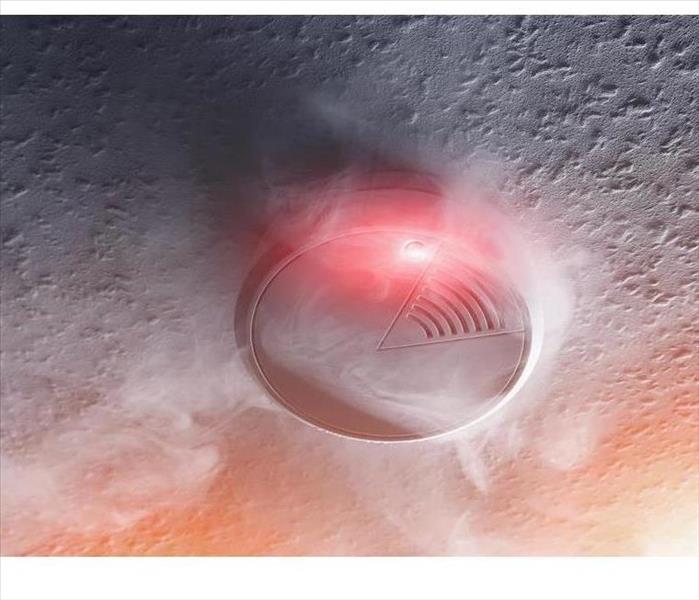 A smoke alarm may be small, but it is mighty when it comes to fire safety and prevention.
A smoke alarm may be small, but it is mighty when it comes to fire safety and prevention.
Selecting the Best Smoke Detector for Your Home
With so many smoke alarm options and brands on the market today, how do you choose the best alarms for your DeBary, FL, home? Below, you will learn about the different types of alarms available, the differences in power sources, and the various price ranges and add-on features.
What Type of Smoke Alarm?
Regardless of home size or layout, place alarms in each bedroom, outside sleeping areas, and on each floor. There are two types of alarms available:
Photoelectric sensors use a light beam to detect reflected light off particles inside the chamber. These sensors respond best to smoldering fires.
Ionization sensors measure a disruption in the electric current or ion flow inside the chamber. These sensors respond best to flaming fires.
You never know which type of fire will break out, so the recommendation is you install a combination of photoelectric and ionization alarms. You can also buy dual-sensor alarms for the same purpose.
What Power Source?
Alarm systems are either hard-wired or battery-powered. Hard-wired alarms are tied into the home’s electricity, have backup batteries in case of power outages, and typically require professional installation. Battery-powered alarms use standard batteries that need replacing once or twice a year, and they can be self-installed. No matter the power source, make sure you buy models that can be interconnected throughout the house. Ensure alarms are placed high on walls or ceilings, away from HVAC and fans, and at least 10 feet from cooking sources to limit interference.
What Price and Features?
A basic battery-powered single-sensor smoke detector can cost as little as $10. Added features or installation requirements can increase costs by more than $100. Some features to consider are voice alert, strobe light functions for the hearing impaired, and advanced systems that connect to your security system. Advanced systems will notify your associated app and the local fire department immediately, which can save time and money on home restoration services.
A smoke alarm may be small, but it is mighty when it comes to fire safety and prevention. Several options are available depending on your needs, preferences, and finances.
When To Use a Flood Cut
8/27/2022 (Permalink)
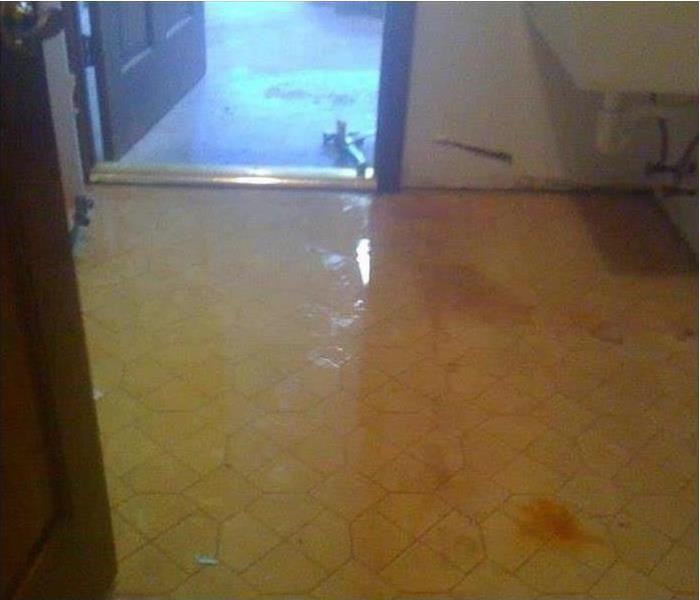 If the damage to your home is caused by flooding from a recent storm in Pierson, FL, however, the walls are probably going to have to go.
If the damage to your home is caused by flooding from a recent storm in Pierson, FL, however, the walls are probably going to have to go.
When Should You Use a Flood Cut?
If you experience flooding after a storm, you may hear the flood restoration experts who are tasked with mitigating the damage talking about a flood cut. A flood cut is a mark that is made on the wall that tells technicians how much of the wall has to be removed. Such measures are not always necessary with all water damage, but there are times when taking out walls cannot be avoided.
Saving the Wall
Not all damage to your home is the same. Experts consider some types of water damage relatively minor, such as:
• Damage by clean water
• Small spills
• Superficial damage that doesn’t reach the drywall
If the water doesn’t actually permeate the wall or contaminate it with microbes, there is no reason to tear out the drywall. Technicians can just dry the area to prevent secondary damage from occurring.
Removing the Wall
If the damage to your home is caused by flooding from a recent storm in Pierson, FL, however, the walls are probably going to have to go. Flood water is considered Category 3 water, which means it is likely contaminated with bacteria and other microorganisms. You do not want these germs remaining on your walls. Unfortunately, there is not really a good way to clean the walls. They have to be removed and replaced.
Technicians start by making a flood cut about 12 inches above the highest visible damage. This distance may seem excessive, but it ensures that all the contamination is removed, even if the damage isn’t obvious. Once the wall is down, the technicians can check to see if anything inside the wall was affected, such as the insulation. After the area is dry and clean, the wall can be rebuilt.
Flooding from a storm can destroy your walls by saturating them with contaminated water. Such damage can only be dealt with by tearing it out and throwing it away. A flood cut helps ensure that all the damaged materials are removed.
4 Tips To Prevent Frequent Toilet Overflows
8/22/2022 (Permalink)
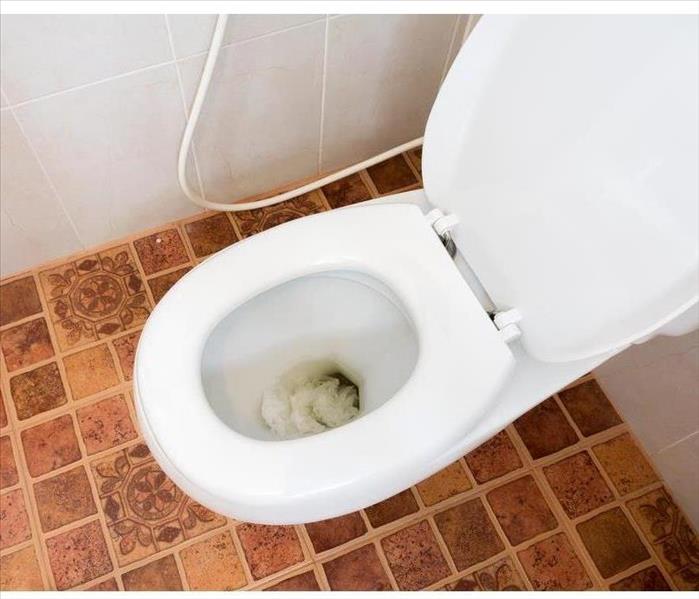 Avoid battling clogged toilet problems around the clock by making some changes in your restroom setup.
Avoid battling clogged toilet problems around the clock by making some changes in your restroom setup.
Prevent Frequent Toilet Overflows
Commercial bathrooms have people in and out of them throughout the day. This high traffic makes it harder to control people's actions; thus, overflows and clogs have a greater probability. However, as an owner in DeLand, FL, you don't want to face a clogged toilet regularly.
Minimize those frustrations by making several choices to reduce blockages and encourage others to use proper restroom etiquette. Here are four tips to keep toilets running smoothly.
1. Post Helpful Suggestions
Friendly, gentle reminders can go a long way. Hang printed signs in the bathroom stalls asking patrons and employees to make appropriate decisions. Request they put all trash in the receptacles. Explain that feminine products clog lines and lead to a toilet overflow.
2. Have Trash Cans in Visible Locations
Focus on convenience. People may toss excess paper and items into the toilet when they don't see another viable option. Therefore, if you only have one trash can in the restroom and it's not easy to find or use, the commode becomes the other choice.
Have a small can near each toilet. While staff may have more to empty, people are likely to drop waste there rather than down the drain.
3. Check Often for Signs of a Clogged Toilet
Assign restroom check duties. Have employees go into the restroom throughout the day. They can ensure it's clean and quickly flush test each unit. If one is working slowly, making unusual sounds or beginning to fill, have staff report it immediately. Someone can snake the drain before an overflow occurs.
4. Invest in Commercial-Grade Toilet Paper
While soft, thick toilet paper offers comfort, it clogs drains if people use too much. These wads block the sewage line. Swap it out for a thinner material. You can't control everyone's consumption, but you can choose selections that break down easier.
If a flood happens, rely on professional water remediation experts in DeLand, FL, to help. In the meantime, avoid battling clogged toilet problems around the clock by making some changes in your restroom setup.
 At SERVPRO Team Cuthbertson, we believe that investing in our employees’ development is crucial for fostering a thriving workplace.
At SERVPRO Team Cuthbertson, we believe that investing in our employees’ development is crucial for fostering a thriving workplace.






 24/7 Emergency Service
24/7 Emergency Service








